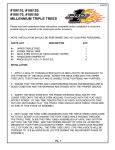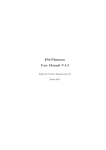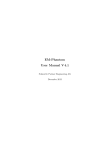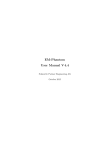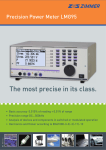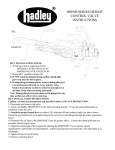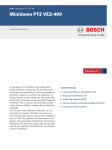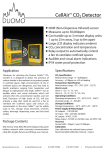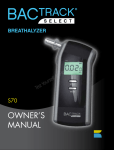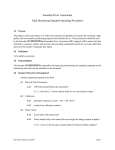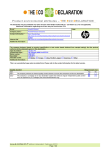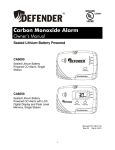Download 3-In-1 Carbon Monoxide - Propane
Transcript
Safety Siren™ Carbon Monoxide, Propane & Methane DETECTOR Owner's Manual Model Number HS80004 HS80104 HS80204 HS80504 ©Copyright, 1996 All Rights Reserved Family Safety Products, Inc. 2879 Remico SW Grandville, MI 49418 (616) 530-6540 • Family Safety Products Inc. FACTS AND CONCERNS ABOUT CARBON MONOXIDE: Table of Contents Facts and Concerns about Carbon Monoxide and Combustible Gas .... Sources of Carbon Monoxide .................... • . ..... 5 Sources of Combustible Gas. . ..... 6 Symptoms of Car-bon Monoxide Poisoning ............ . .... 7 Operating Instructions. Installation ................. . Location of the Detector .................• . ..... 9 Testing Safety Siren™ for Carbon Monoxide and Combustible Gas ........................ .. ....... . ...... 9 What to Do When the Alann Sounds For Carbon Monoxide. For Combustible Gas Carbon Monoxide (CO) is a colorless, odorless, tasteless gas , which is VI .y toxic and nearly impossible to detect without the use of sensing equipment. Carbon monoxide can be absorbed into the body's bloodstream nearly 10 times faster than pure oxygen. Thus it can limit the body's ability to absorb oxygen whenever carbon monoxide is present, even in smaIl amounts. This reduced ability of the body to absorb oxygen is known as chemical asphyxiation and it can result in death whenever carbon monoxide is present in small quantities over a period of time. . ........ 10 10 SafetySiren™ for Carbon Monoxide and Combustible Gas Sensor Specifications 11 Warranty 12 As the level of carbon monoxide rises in a closed environment, the toxic effects require less and less ti me to occur. This relationship can be seen in Figure I. While it takes over three hours for an atmosphere with 0.01 % CO to produce a headache, it takes only one hour for 0.02% CO to produce the same effects. At 0.04% CO the time required to produce the same headache is only 25 minutes. The HS 80004 SafetySiren™ unit is designed to generate an alann at the foIlowing exposure levels as defined by Underwriters Laboratories: in less than 90 minutes at 0.01 % CO (100ppm CO) in less than 35 minutes at 0.02% CO (200ppm CO) in less than IS minutes at 0.04% CO (400ppm CO) Warning: This device may not alann at low carbon monoxide levels. The federal Occupational Safety and Health Administration (OSHA) has established that continuous exposure to CO levels of 50 ppm should not be exceeded in an eight hour period. This detector has not been investigated for carbon monoxide detection below 100 ppm. Individuals with a medical condition may consider using a more sensitive device. Sources of Carbon Monoxide: Figure 1 - Carbon Monoxide Concentration versus Time and % COHb Carbon Monoxide Concentration PPM CO VS. MINUTES A - 50% COHb (Permanent Brain Damage - Death) B - 45% COHb (Coma & Permanent Brain Damage) C - 40% COHb (Collapse) D_ - 35% COHb (Vomiting) ...,j,l\+~'tt--+--+-+--I E - 30% COHb (Drowsy) () F - 25% COHb (Headache & Nausea) -IffiJf\JjlAA~--+-+--j G - 20% COHb (Headache) ::!!: H -15% COHb (Slighl Headache) C. I -10% COHb (None) c.. J - 50/. COHb INone) Carbon monoxide results from incomplete combustion of carbonbased fuels such as natural gas, charcoal, wood, coal, heating oil, kerosene, gasoline and propane. Many of these fuels can be found throughout the home, for example in kitchen appliances, furnaces, water heaters, fIreplaces, portable heaters, barbecue grills, and automobiles. If incomplete combustion occurs in any of the ofthe devices shown below and they are improperly vented to the outside, the danger of CO poisoning exists. -1.\1\\\\\11\---1--+-+--1 Figure 2. Sources of carbon monoxide o Water Heater MINUTES • Fireplace 4 Automobile Space Heater Furnace Charcoal Grill Sources of Combustible Gas Symptoms of Carbon Monoxide Poisoning Disastrous explosions can occur from leaks of combustible gases, such as natural gas (methane) and LPG gas (propane). These gases are used to fuel a variety of common appliances found in the home. Cooking stoves/ovens, hot-water heaters, clothes dryers, space heaters, fireplace starters, and heating furnaces are the most common gas-fuel burning appliances. Natural gas and propane can cause devastating explosions from even the smallest leaks from any of these appliances. The following symptoms are related to carbon monoxide poisoning and should be discussed with all members of the household: l\1:ild Exposure: Slight headache, nausea, vomiting, fatigue (often described as "flu-like" symptoms). Medium Exposure: Severe throbbing headache, drowsiness, confusion, rapid heart rate. Extreme Exposure: Unconsciousness, convulsions, cardiopulmonary failure, death. Sources of Combustible Gases • 41) Fireplace Furnace Space Heater Water Heater 6 -Dryer Stove Many cases of reported carbon monoxide poisoning have indicated that although victims were aware they were not well, they became disoriented to the point they were unable to save themselves by either exiting the building or calling for assistance. Young children and household pets may be the first affected by CO poisoning. OPERATING INSTRUCTIONS Installation This HS 80004 SafetySiren™ Carbon Monoxide and Combustible Gas Sensor plugs directly into a standard 11O-volt AC household outlet. The unit should be oriented vertica11y so that all of the script on the face of the unit appears in the upright position. The ventilation slots must not be blocked and the unit must be kept dust free. A proper airflow must be maintained through the unit to obtain an air sampling representative of the local environment. The only maintenance the unit requires is a thorough vacuuming once every six months. occurred in the unit. If either condition exists, disconnect the unit from the AC power immediately and call Family Safety Products at 616-5306540. WARNING: Make sure that the unit ~ not plugged into a wall outlet controlled by a light switch. CAUTION: This carbon monoxide and combustible gas detector is designed to detect carbon monoxide gas and ANY source of combustion or the combustible gases of methane and propane. It is NOT designed to detect smoke, fire, or other gases. \VARNING: There are no user serviceable parts inside the unit. Do not remove the back cover. Removal of the back cover will void the warranty. CAUTION: When the unit has been stored unplugged for several weeks, its sensitivity to combustible gases will decline. To restore the unit to normal sensitivity, allow a 24-hour warmup period. Once the unit is plugged into the wall outlet, the green power indicator should light up. The red indicator will flash approximately once every three seconds to indicate the unit is operating properly. It should be noted that the sounding of the alarm will indicate whether the sensor has detected unsafe levels of CO or combustible gas. Continuous appearance of the red indicator and the continuous sounding of the audible buzzer indicates a presence of potentially dangerous levels of CO. Continuous appearance of the red indicator and the intermittent sounding of the audible alarm indicates the presence of potentially dangerous levels of combustible gases. If the unit begins beeping once every 5 seconds or the red LED light is not flashing once very 3 seconds, then a fault has 9 Location of the Detector The Consumer Product Safety Commission recommends that each household have at least one Carbon Monoxide detector placed in the sleeping areas of the horne. A second detector located near appliances or equipment using combustible fuel adds an extra measure of safety. Figure 3 shows suggested locations in the home. Make sure that airflow through the unit's ventilation slots is not inhibited by curtains, furniture or other items. The audible alarms should be able to be heard from all sleeping areas in the home. Units must not be placed within five feet of open flame cooking appliances. Also, avoid placing units near paint thinner fumes or in areas where the temperature varies outside the range of 40.0oF (4.4°C) to 100"F (37.S"C). CAUTION: This detector will only indicate the presence of carbon monoxide and combustible gas at the sensor. Carbon monoxide and combustible gas may be present in other areas. Figure 3 - Suggested locations for SafetySiren™ for Carbon Monoxide and Combustible Gas sensors. 10 Testing the SafetySiren™ for Carbon Monoxide and Combustible Gas Sensor To verify the circuitry is operating properly, use the TestlReset button built into the unit. Simply press down on the button during normal operation and note the red indicator. The red indicator will light continuously and the audible alarm will sound as long as the button is held down. Once you release the TestlReset, the red indicator will return to blinking at a three-second rate and the audible alarm will cease, indicating the unit has returned to a normal operating mode. Test the unit monthly. If the unit begins beeping once every 5 seconds or the red LED light is not t1ashing once every 3 seconds, then a fault has occurred in the unit. Disconnect the unit from the AC power immediately and call Family Safety Products at 616-530-6540. Resetting the Alarm The Test / Reset button may also be used to reset the audible alarm during the alarm mode. Once the alann is activated by detection of high CO or combustible gas levels, simply press the TestlReset button to disable the audible alarm. If the high CO level or combustible gas level continues, the audible alarm will again sound within a 2.5 minute period. The red indicator will remain lit during the time the audible alarm is disabled, indicating that the alarm condition still exists. 11 WHAT TO DO WHEN THE ALARM SOUNDS WARNING If a continuous alarm sounds for Carbon Monoxide Activation of this device indicates the presence of carbon monoxide which can be FATAL. 1) If anyone has a headache or an upset stomach, call the Fire Department and move to a location which has fresh air. DO A HEAD COUNT TO CHECK THAT ALL PERSONS ARE ACCOUNTED FOR. DO NOT RE·ENTER THE PREMISES UNTIL IT HAS BEEN AIRED OUT AND THE PROBLEM CORRECTED! If no one exhibits symptoms of discomfort associated with carbon monoxide poisoning, simply: 2) Operate the reset button, 3) Turn off appliances, vehicle, or other sources of combustion at once (furnace, water heater, wood burning stove, RV, automobile, or the like). If the intermittent alarm sounds for Combustible Gas An intermittent audible alarm from this device indicates the presence of combustible gases, the source of which may be an appliance such as a furnace, water heater, oven/stove, or dryer. • Do not operate any electrical devices such as light switches or telephones. • Do not plug or unplug any electrical devices because they may cause a spark. • Immediately extinguish any flames or pilot lights. • Ventilate the area by opening doors and windows. • Determine the source of the gas. Seek a qualified technician or call your local gas company. • Turn off the gas supply. 4) Get fresh air into premises or vehic1e, 5) Cal1 a qualified technician and have the problem fixed before restarting appliances or vehicle. 12 13 SafetySiren™ for Carbon Monoxide and Combustible Gas Sensor Model HS 80004 Specifications Power Source .............. 11O-volt AC/60Hz at 15 Watts CO Sensor CG Sensor . . . CO Sensor calibrated at 200 ppm CO specific to avoid false alarms. ......... Alarm trip-point set at less than 25% LEL (Lower Explosive Limit) 3.8% by volume Natural gas (methane) in air 2.1 % by volume LP-gas (propane) in air Temperature ............... 4.4°C (4(yF) to 37.SoC (IOO"F) CO Audible Alarm .......... Continuous 85dB alann at 10ft. for CO CG Audible Alann Visual Alarm ..... Intennittent alarm for Combustible Gas .. (3 second blinking rate for nonnal operation). Continuous RED LED during alarm condition. Green LED Operation ....... Continuous Operation When Power On Detection frequency ......... Air sampled every 2.5 minutes for CO. Air sampled continuously for Combustible Gas after an initial warm-up of 2.5 minutes Test .. Dimensions Weight . ......... Test button verifies proper operation when unit is in normal operation. Once in alarm mode the Test button will reset audible alarm until next air sampling .... 4.7 inches x 3.1 inches x 2.1 inches ......... 12 ounces 14 Limited Warranty Your Safety Siren™ for Carbon Monoxide and Combustible Gas has a five-year warranty from date of purchase against defects in material and workmanship. Units returned to the manufacturer during this period because of such defects will be repaired or replaced free of charge. For repairs within the warranty period or receipt of a faulty unit, call Family Safety Products at 616-530-6540 to receive a Return Authorization Number (RAN). Include a written description of the problem. You may then ship the unit to the address listed below along with the RAN, and proof of purchase. The warranty covers only defects in material or workmanship in nonnal use and not damage from negligent handling, misuse, or lack of proper care. Important: Do not remove the back cover. Such removal will void the warranty. This warranty stands in place of any other warranty either expressed or implied. Family Safety Products, Inc. is not liable for any personal injury, property damage or any incidental or consequential damage resulting from gas leakage, fire, or explosion. The sole remedy for breach of this limited warranty does not, in any instance, exceed the purchase price. Your SafetySirenrM for Carbon Monoxide and Combustible Gas sensor does not constitute property, disability, life or any other type of insurance. This warranty gives you specific legal rights. You may also have other rights which vary from state to state. Family Safety Products, Inc. 2879 Remico SW Grandville, MI 49418 USA 15








